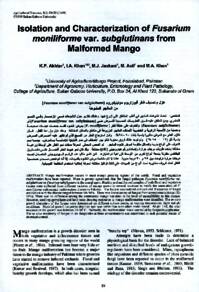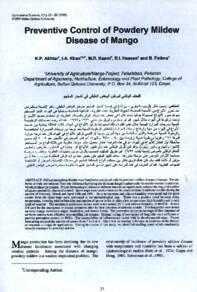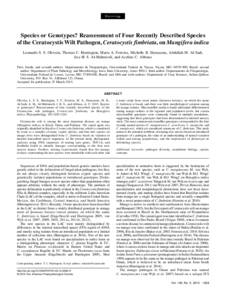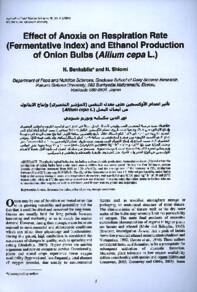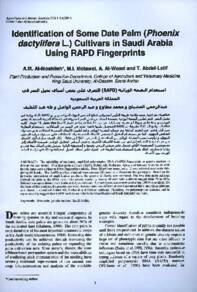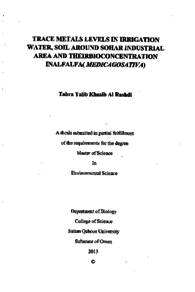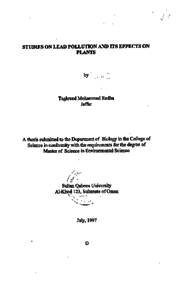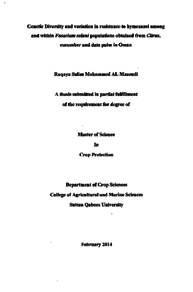Document
Isolation and characterization of fusarium moniliforme var. subglutinans from malformed mango.
Contributors
Publisher
Sultan Qaboos university
Gregorian
1999
Language
English
English abstract
Mango malformation occurs in most mango growing regions of the world. Floral and vegetative malformation have been reported. There is general agreement that the fungal pathogen Fusarium moniliforme var. subglutinans or Fusarium subglutinans is the causal agent. Healthy and malformed samples of both floral and vegetative tissues were collected from different varieties of mango grown in several locations to verify the association of F. moniliforme with mango malformation discase in Pakistan. The fungus was isolated and cultured. Frequency of fungal association with the disease ranged between 90- 94%. There was less recovery of fungus from asymptomatic tissue (12- 15%). There was no difference among the commercial mango varieties in the level of susceptibility to this disease. However, seedling germplasm and land races showing resistance to mango malformation were identified. The in vitro growth characters of the fungus were determined on different culture media, at varying temperatures, light and pH conditions. Mycelial growth on potato dextrose agar was better than nine other media tested. At pH 7.00, the ideal temperature for growth was bettween 25-30°C. Normally, the malformation is not controlled by fungicide application. The in vitro sensitivity of fungus to six fungicides at three concentrations was determined to seek potential means of chemical control.
Member of
ISSN
2410-1079
Resource URL
Citation
Akhtar, k. P., Khan, I. A., Jaskani, M. J., Asif, M., & Khan, M. A. (1999). Isolation and characterization of fusarium moniliforme var. subglutinans from malformed mango. Journal of Agricultural and Marian Sciences, 4 (2), 19-25.
Arabic abstract
تحدث تشوهات الماجو في أغلب المناطق التي تزرع فيها، وهناك تقارير حول التشوهات في الأزهار وفي النمو الخضري. ومن المتفق عليه فإن الفطريات المسببة للمرض هي (Fusarium moniliforme var . subglutinans ) أو ( Fusarium subflufinanas ) وللتعرف على علاقة فطر ( F . moniliforme ) بمرض التشوه فند جمعت عينات صحيحة ومصابة من الأنسجة الزهرية والخضرية لأصناف المتجر المزروعة في مناطق باكستان المختلفة. وعند عزل وزراعة الفطر، كان تلازم الفطر مع المرض متكررا بنسبة بلغت 90-94%. وكان استرجاع الفطر من النسيج الذي لم تظهر عليه أعراض المرض بنسبة أقل (12-15%). ولم توجد هناك فروق معنوية تذكر بين الأصناف في مدى قابليتها للإصابة بالمرض، بينما تم التعرف على أنواع بذرية وفصائل مقاومة لمرض تشوه المانجو، تم الفحص المعملي لمعرفة صفات نمو الفطر على أوساط زراعية مختلفة وتحت ظروف درجات حرارة وإضاءة ورقم هيدروجيني (pH) مختلفة. وقد كان نمو خيوط الفطر أفضل على دكستروز البطاطس مقارنة بتسعة أنواع أخرى من الأوساط الزراعية تم اختبارها. كان النمو مثاليا عند الرقم الهيدروجيني المتعادل تحت درجات حرارة تراوحت بين 25 و 30 درجة مئوية. عادة لا تتم مكافحة مرض التشوه بالمبيدات، إلا أنه تم فحص مدى حساسية الفطر تحت ظروف مختبرية لستة أنواع من المبيدات على ثلاث تراكيز مختلفة لمعرفة إمكانية استخدام المكافحة الكيميائية.
Category
Journal articles

